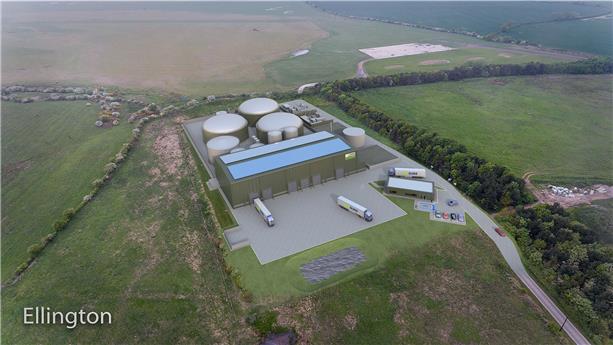
About SUEZ
Who is SUEZ?
SUEZ recycling and recovery UK is one of the country’s leading providers of innovative recycling and waste management services.
We employ more than 5,500 people in the UK and since 1988, have been managing waste for our local authority and business customers.
SUEZ has had a presence in the North East for over 25 years and currently employs 516 people in the region across 33 sites.
Has SUEZ got experience of developing and operating anaerobic digestion facilities?
The proposal
How much energy will the facility generate?
How will you get the gas from the facility to people's homes and businesses?
Our facility will either send gas directly into the local gas network after cleaning, or turn it to electricity, via gas-powered generators, and export it to the local electricity grid.
One of the reasons why our Ellington Road site was chosen for the anaerobic digestion facility was its proximity to the gas grid operated by Northern Gas Networks, with a likely connection point immediately outside the Ellington Road site.
What is anaerobic digestion and how does it work?
Why is it a good idea?
SUEZ is working to help reduce food waste and put food that is wasted to good use generating renewable energy in accordance with the government’s Our Waste, Our Resources Strategy for England. The anaerobic digestion facility can help the government meet its ambitions to eliminate food waste going to landfill by 2030. In addition, the biogas created from food waste provides a source of renewable energy. The gas and electricity generated by the facility would be exported to the local distribution network and electricity used to power the plant.
One of the major benefits of anaerobic digestion is the reduction in carbon dioxide and other greenhouse gases released into the atmosphere, as a result of the following:
- Putting food waste to good use by generating renewable energy and recovering nutrients to return to the land.
- Renewable energy generated by the facility and therefore the reduction of carbon dioxide (CO2) released from fossil fuels.
What is the anticipated timeline?
Before submitting a planning application, SUEZ will be running a two-week consultation between 27 June to 10 July 2022 to inform the local community and stakeholders about the proposals for the anaerobic digestion facility.
Once the consultation period has concluded and SUEZ has reviewed the feedback, a planning application will be submitted over the summer.
If approved, construction could begin in 2023 and operation of the facility in 2025.
The impacts
What traffic impacts will there be during construction and operation?
Construction traffic will be subjected to a Traffic Management Plan, agreed with the local authority, to ensure safe movement in and around the site. It is expected that traffic will move via the A189 and the A1068 to avoid residential areas.
During operation, it is anticipated that the anaerobic digestion facility will replicate the existing vehicle movements delivering waste to be treated. These deliveries to the facility are expected to be restricted in-line with current conditions restricting movements to 125 vehicles per day across the entire site and will only take place between 07:00–20:00 Monday to Friday and 07:00–17:00 on a Saturday.
What are the working times for the facility?
Anaerobic digestion is a continuous process and so the facility would operate 24/7 in line with the existing permission for the in-vessel composting facility which allows continuous work.
However, HGV deliveries to site will only take place between 07:00 and 20:00 Monday to Friday and 07:00 and 17:00 on a Saturday.
Will there be odour released from the facility?
What will the visual impact be?
The proposed anaerobic digestion facility will be around 1km away from Ashington, the closest town or village to the site.
The new anaerobic digestion facility will have a similar footprint to our existing in-vessel composting facility. The building will be approximately 1,950m2 in area and have a maximum height of 17 metres. The digester tanks will have a diameter of 32 metres and a maximum height of 15.5 metres. The other tanks will be no higher than 17 metres.
It is not proposed that these will be visible from the north due to the site being situated on a lower level than the other facilities at Ellington Road, which acts as natural screening. It will be visible from the south and west, but it is anticipated that the buildings will blend into the local landscape in a similar fashion to the existing facility and the development will be purposefully coloured to further blend into the landscape. A landscape appraisal will be submitted as part of the planning application to assess any impacts.
Will there be increased noise during construction and operation?
Consulting process
Will you be consulting local communities?
Yes. From 27 June 2022 to 10 July 2022, a public consultation is being held to gather feedback from local communities and organisations before submitting our application.
All comments and responses will be taken into consideration as we continue to develop our proposals.
You will have further opportunity to give formal feedback during the planning determination process after we have submitted our planning application to Northumberland County Council and the statutory period of consultation opens.
During this time, you will be able to comment on the planning application via the council’s planning portal.
Community benefits
Will local communities benefit from the project? If so, how?
We anticipate that up to five local jobs will be associated with the operation of the anaerobic digestion facility.
Additionally, SUEZ Communities Trust provides funding awards of up to £50,000 to not-for-profit organisations near to our sites. Projects must be eligible under the rules of the Landfill Communities Fund. The Trust will consider projects which focus on long lasting physical improvements at a specified site or amenity. Funding is typically awarded for the purchase of materials, equipment and the appointment of a contractor to undertake the improvement work. The Trust does not fund staff posts, organisational running costs, training, events, vehicles or projects on school sites.
If you’re interested in applying for funding, please visit the Trust’s website at suezcommunitiestrust.org.uk.
Get in touch
If your question hasn't been answered, get in touch by filling out our feedback form or by phone on 0191 258 8275.

